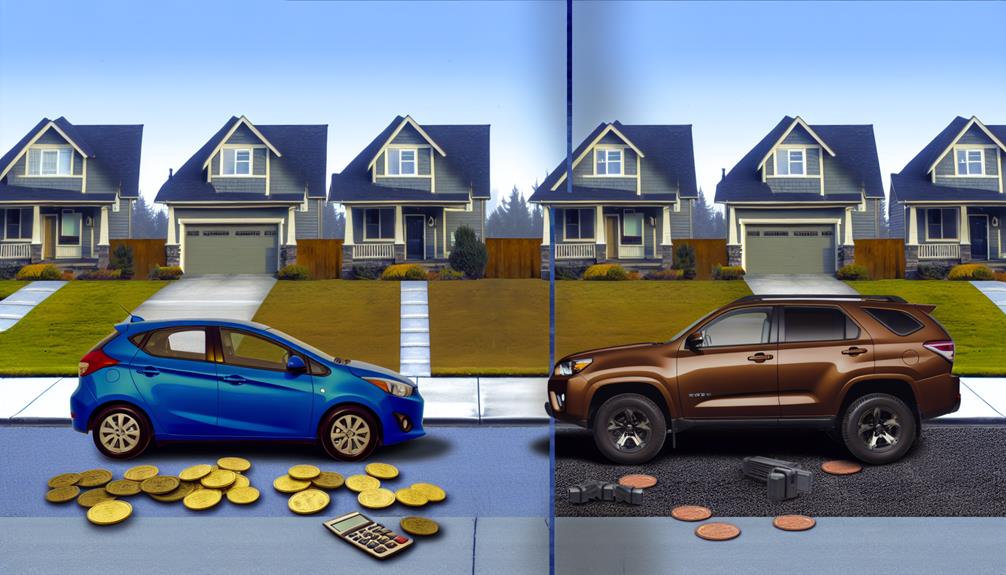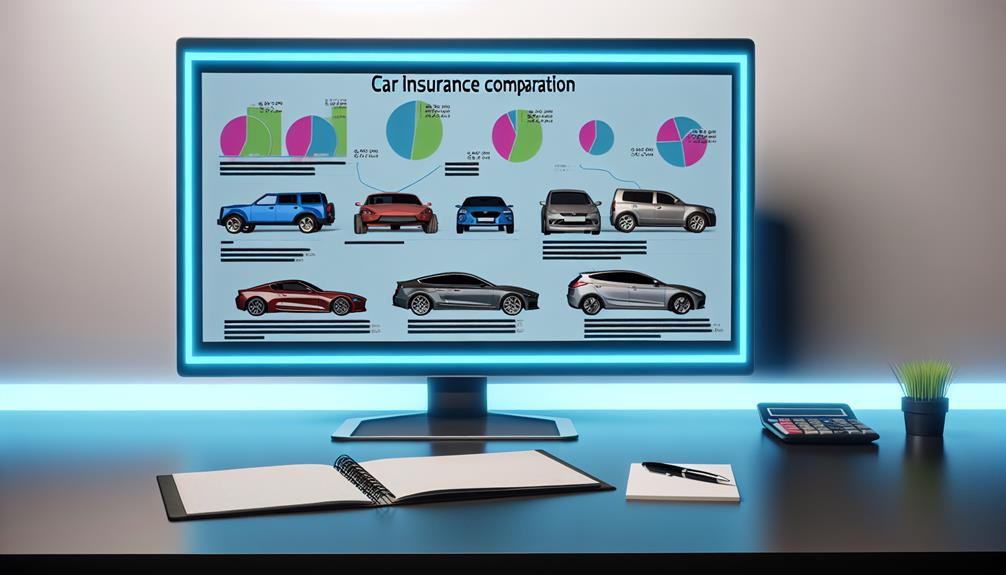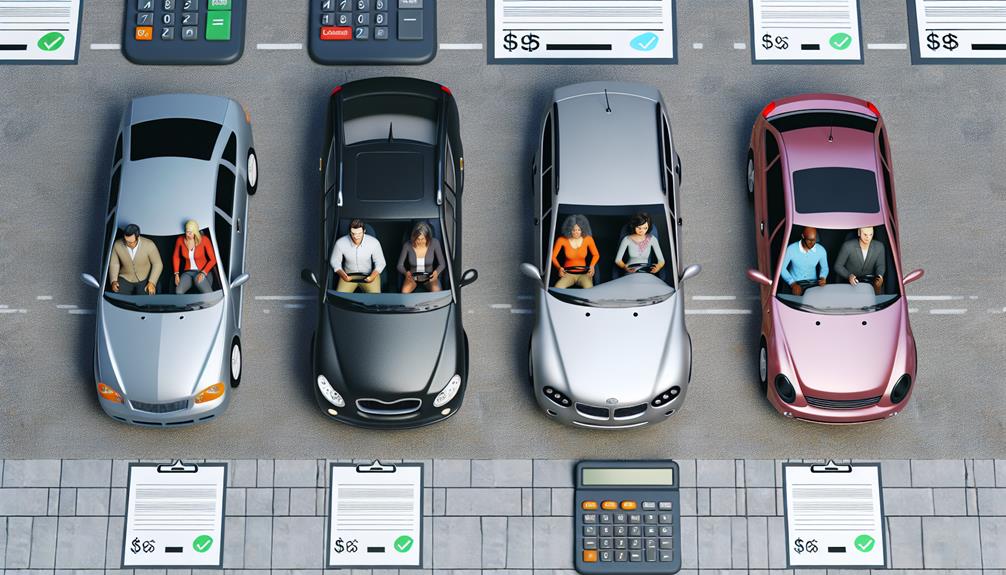Isn't it intriguing how some cars come with sky-high insurance rates while others seem to barely make a dent in your wallet? To make sense of this disparity, you'll want to start by gathering key details about your vehicle and exploring various online comparison tools. By inputting consistent coverage levels across multiple insurers, you can uncover surprising differences in quotes. But there's more to it than just numbers—understanding the factors that affect these rates can greatly alter your approach. What hidden insights could you discover that might save you money?
Key Takeaways
- Gather detailed information on the vehicle types you wish to compare, including make, model, and safety features.
- Use online comparison tools to obtain multiple insurance quotes simultaneously from various insurers.
- Ensure all quotes reflect identical coverage limits and deductibles for accurate comparisons.
- Analyze quotes by evaluating coverage options, customer service ratings, and claims processes for informed decision-making.
- Regularly review and compare insurance policies to identify potential savings and adjust coverage as needed.
Factors Influencing Insurance Rates
When it comes to car insurance rates, several key factors play an essential role in determining what you'll pay. First, the vehicle make and model greatly influences your insurance premiums. Luxury and high-performance vehicles usually incur higher rates due to their increased repair costs and accident risk. The body style also matters—sporty coupes often come with elevated premiums compared to larger, safer options like vans or SUVs.
Safety features can help lower your insurance costs, as they decrease the likelihood of accidents. Conversely, vehicles with high theft rates will lead to increased premiums for full coverage. Additionally, the age and value of the vehicle impact insurance rates; newer cars typically cost more to insure due to higher repair or replacement expenses.
Personal factors like your driving history, location, and demographics—such as age, gender, and marital status—also greatly affect your rates. Younger, less experienced drivers usually face higher premiums. By considering these factors and comparing car insurance quotes, you can better understand how to find the right coverage at an affordable price.
Average Rates by Vehicle Type
Understanding average insurance rates by vehicle type can save you both time and money. When you're comparing options, compact cars are often your best bet for budget-friendly insurance premiums, averaging around $1,300 to $1,800 annually. On the other hand, minivans and family-oriented vehicles typically enjoy similar rates, reflecting their safer designs and lower accident statistics.
If you're considering SUVs, be prepared for a wider range of insurance costs. Depending on the model's safety ratings, full coverage car insurance for SUVs can average between $1,400 and $2,200. Luxury vehicles, like BMW and Mercedes, usually come with higher premiums that can range from $2,500 to $4,000 annually due to the costs associated with repairs and theft.
However, if you're eyeing a sports car, brace yourself for steep insurance premiums, often exceeding $3,000 a year. The increased risk factors tied to high performance and driver behavior greatly contribute to these costs. By understanding these average insurance rates by vehicle type, you can make informed decisions that align with your budget and lifestyle.
Understanding Vehicle Makes

The make of your vehicle plays a significant role in determining your insurance premiums. Different manufacturers have varying reputations for safety and reliability, which heavily influence insurance rates. Understanding these factors can help you make informed decisions about your vehicle choice. Here are three key points to take into account:
- Car models: A high-performance model, like a Ford Mustang, typically incurs higher rates compared to a standard model like a Ford Fusion.
- Trim levels: Higher trims with advanced features often lead to increased insurance costs due to their higher repair expenses and greater value.
- Theft rates and accident statistics: Researching these figures for specific makes and models can provide insight into potential insurance costs.
When you look at a vehicle, remember that its age and safety ratings are important too. Newer vehicles usually attract higher premiums due to expensive repairs. Additionally, using the vehicle identification number (VIN) can help you get detailed information about your car's history, potential theft rates, and accident statistics. By grasping these aspects of your vehicle make, you'll be better equipped to compare insurance rates effectively.
How to Obtain Estimates
Obtaining car insurance estimates is a crucial step in finding the best coverage at the most affordable price. Start by identifying the make and model of your vehicle, as these details greatly influence premium rates. Use online quote tools to gather estimates from multiple insurance providers. Make sure you input identical coverage limits and deductibles for accurate comparisons.
Here's a quick reference table to help you understand key factors:
| Factor | Impact on Premium Rates |
|---|---|
| Vehicle Age | Newer vehicles typically cost more |
| Body Type | SUVs may have higher rates than sedans |
| Safety Features | Advanced features can lower rates |
When obtaining insurance estimates, provide essential personal information, including your age, driving history, and location, as insurers base their quotes on these demographics alongside vehicle details. Regularly compare quotes every six months or when changing vehicles, as rates can fluctuate based on market conditions and personal circumstances. This proactive approach helps you secure the best coverage for your specific vehicle type at the lowest possible price.
Tips for Saving on Insurance

When it comes to saving on car insurance, every little bit counts. You can take several steps to lower your car insurance premiums and keep more money in your pocket. Here are some effective tips:
- Bundle your policies: Combining auto and home insurance can save you up to 25% on your premiums.
- Maintain a clean driving record: Drivers without violations typically receive lower rates and additional discounts.
- Consider usage-based insurance: If you drive less frequently, these programs can reward you with lower rates.
Additionally, don't forget to review your insurance policies regularly. This helps you compare quotes and spot better deals, potentially saving you hundreds of dollars each year. You might also consider increasing your deductibles; just be sure you're financially prepared for higher out-of-pocket costs if you need to file a claim.
Importance of Comparing Quotes
Comparing car insurance quotes can make a world of difference in what you pay for coverage. Each insurer uses unique methods for setting rates, which means that you could see significant variations in insurance premiums for similar coverage. By regularly comparing quotes, you can identify potential savings, as rates often fluctuate over time and different companies may offer new discounts or promotions.
To get a thorough view of your options, it's recommended that you obtain quotes from at least two or three insurance companies. Make sure that all quotes reflect identical coverage levels, deductibles, and eligible discounts to guarantee a fair assessment of insurance costs. This will allow you to make informed decisions about your insurance coverage.
Using online comparison tools can streamline the process of gathering multiple quotes. These tools save you time and help you easily compare car insurance rates from different insurers. By taking the time to explore your options, you'll be better equipped to find the best deal that meets your needs, allowing you to secure the right coverage at the most competitive annual rates.
Utilizing Comparison Tools

Finding the best car insurance rates can be made easier with the right comparison tools. These tools help you streamline the process of gathering quotes from various insurance providers for different vehicle types. Here's what to look for:
- Multiple quotes: Choose tools that allow you to compare quotes from over 100 insurers with just one form.
- Unbiased comparisons: Confirm that the comparison platform offers genuine quotes instead of acting as a lead aggregator.
- Privacy awareness: Review privacy disclosures to keep your information secure and avoid unwanted contacts.
When utilizing comparison tools, always verify that the estimates reflect the same coverage levels and deductibles. This makes your evaluations across different vehicle types accurate. If you prefer a more personalized approach, consider working with independent agents who can provide tailored options based on your specific needs. These agents can gather multiple quotes, giving you a thorough view of what's available. By effectively using comparison tools, you can make informed decisions that suit your driving habits and financial situation. So, take advantage of these resources to find the best auto insurance coverage for you!
Frequently Asked Questions
How Does the Type of Vehicle Influence the Cost of Auto Insurance?
The type of vehicle you drive notably influences your auto insurance costs. Luxury and high-performance cars usually come with higher premiums due to expensive repairs and theft risks. Vehicles with better safety ratings often lead to lower rates, while body styles like convertibles and sports cars attract higher costs. Additionally, compact cars are generally cheaper to insure than larger SUVs, and newer models typically incur higher rates compared to older vehicles.
What Cars Get the Best Insurance Rates?
Did you know that compact cars can save you hundreds on insurance each year? When you're choosing a vehicle, consider options like the Honda CR-V or Subaru Outback. These models often offer the best insurance rates due to their excellent safety ratings and low theft rates. By focusing on economy cars or smaller vehicles, you'll likely find yourself enjoying cheaper premiums and greater peace of mind on the road.
Do Different Cars Have Different Insurance Rates?
Yes, different cars do have different insurance rates. When you choose a vehicle, you're actually influencing your insurance premiums. Luxury cars often cost more to insure due to high repair costs and theft rates, while economy cars typically have lower premiums. Additionally, body styles matter; coupes and sports cars usually attract higher rates than sedans. Finally, safety features, age, and theft statistics play significant roles in determining how much you'll pay for coverage.
Who Typically Has the Cheapest Car Insurance?
When it comes to car insurance, think of it like shopping for a cozy sweater; you want the best fit for your budget. Typically, compact and economy cars wear the cheapest insurance rates, thanks to their low repair costs and solid safety ratings. If you drive a reliable Honda or Toyota, you're likely to save even more. Also, keeping a clean driving record and good credit can make your premiums even lighter on your wallet.
